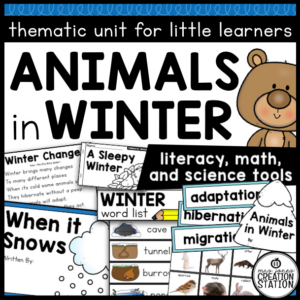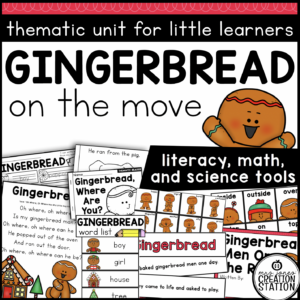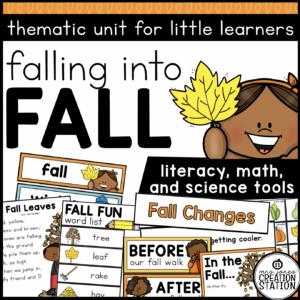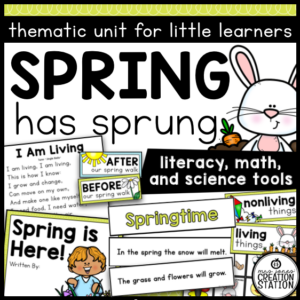ZOO ANIMALS UNIT FOR PRESCHOOL, PRE-K AND KINDERGARTEN
This resources includes thematic lessons, activities, poems, songs and centers about zoo animals for your little learners.
Buy the BUNDLE and SAVE! You can purchase this resources in the Thematic Activities for Little Learners Bundle and the Little Learners Mega-Bundle!
____________________________________________________________________
THIS RESOURCE INCLUDES
Lesson Resources
Week 32 Plans
This is a template for lesson plans during a zoo unit. Pick and choose what ideas and resources work for your learners.
Zoo Animals – Whole Group
These resources can be used during whole group instruction for a zoo theme. They include a poem, word cards, tracing page and table sign in sheets.
Zoo Interactive Poem
Use this poem during a thematic lesson, whole group or a literacy center and have learners learn different types of animals at the zoo.
Lesson Plans
Zoo Animals Thematic Plans
Use these plans as a guide for engaging zoo animal read alouds and activities in the classroom.
Zoo Jobs
Read What Happens at the Zoo? and create a T-chart to find similarities and differences between jobs done by a veterinarian and zookeeper.
Zoo Animals Habitats
Read Zoo Day and create a zoo map using the habitat labels and butcher paper. Discuss why animals are separated by their habitat.
Zoo Animals Habitat Sort
Read View at the Zoo and have learners give an example of an animal that lives in each of the habitats.
Zoo Animals Classes
Read Let’s Classify Animals and discuss why it is important for workers at a zoo to know each animals’ class. Sort the animals on a pocket chart.
Classes Matching
Read ABC Animal Jamboree and have learners match the class to the correct animal using the clues provided.
Zoo Sensory Charts
Explore the zoo with the five senses. Complete the charts together and have learners draw and write about their experience at the zoo using their senses on the interactive page.
Zoo Predictable Chart Class Book
Use this resource to create a class book from the predictable chart created during the week.
Literacy Centers
Literacy Center | Alphabet Puzzle
Have learners match each letter to the animal that begins with that sound.
Literacy Center | Missing Vowel
Have learners find the missing vowel in each of the CVC words.
Literacy Center | Sight Words
Have learners choose a sight word to read, make and write on the mats provided..
Math Centers
Math Center | Measuring
Have learners use the measuring mats to write the length of each footprint. For an extension have them sort the footprints by their size.
Math Center | Number Sort
Have learners sort the number cards on a pocket chart.
Math Center | Size Sort
Have learners sort the animals by whether they are bigger or smaller.
LEARNING STANDARDS INCLUDED IN THIS RESOURCE
Common Core Standards
Language Arts
CCSSL.K.1a
Print many upper- and lowercase letters.
CCSSL.K.2d
Spell simple words phonetically, drawing on knowledge of sound-letter relationships.
CCSSL.K.5a
Sort common objects into categories (e.g., shapes, foods) to gain a sense of the concepts the categories represent.
CCSSRF.K.1b
Recognize that spoken words are represented in written language by specific sequences of letters.
CCSSRF.K.1d
Recognize and name all upper- and lowercase letters of the alphabet.
CCSSRF.K.2d
Isolate and pronounce the initial, medial vowel, and final sounds (phonemes) in three-phoneme (consonant-vowel-consonant, or CVC) words. (This does not include CVCs ending with /l/, /r/, or /x/.)
CCSSRF.K.3
Know and apply grade-level phonics and word analysis skills in decoding words.
CCSSRF.K.3a
Demonstrate basic knowledge of one-to-one letter-sound correspondences by producing the primary sound or many of the most frequent sounds for each consonant.
CCSSRF.K.3b
Associate the long and short sounds with common spellings (graphemes) for the five major vowels.
CCSSRI.K.7
With prompting and support, describe the relationship between illustrations and the text in which they appear (e.g., what person, place, thing, or idea in the text an illustration depicts).
CCSSRL.K.3
With prompting and support, identify characters, settings, and major events in a story.
CCSSSL.K.3
Ask and answer questions in order to seek help, get information, or clarify something that is not understood.
CCSSSL.K.5
Add drawings or other visual displays to descriptions as desired to provide additional detail.
CCSSW.K.2
Use a combination of drawing, dictating, and writing to compose informative/explanatory texts in which they name what they are writing about and supply some information about the topic.
Math
CCSSK.CC.A.3
Write numbers from 0 to 20. Represent a number of objects with a written numeral 0-20 (with 0 representing a count of no objects).
CCSSK.CC.B.4
Understand the relationship between numbers and quantities; connect counting to cardinality.
CCSSK.CC.B.4a
When counting objects, say the number names in the standard order, pairing each object with one and only one number name and each number name with one and only one object.
CCSSK.CC.B.4b
Understand that the last number name said tells the number of objects counted. The number of objects is the same regardless of their arrangement or the order in which they were counted.
CCSSK.CC.B.5
Count to answer “how many?” questions about as many as 20 things arranged in a line, a rectangular array, or a circle, or as many as 10 things in a scattered configuration; given a number from 1-20, count out that many objects.
CCSSK.MD.A.1
Describe measurable attributes of objects, such as length or weight. Describe several measurable attributes of a single object.
CCSSK.MD.A.2
Directly compare two objects with a measurable attribute in common, to see which object has “more of”/“less of” the attribute, and describe the difference. For example, directly compare the heights of two children and describe one child as taller/shorter.
CCSSK.OA.A.1
Represent addition and subtraction with objects, fingers, mental images, drawings, sounds (e.g., claps), acting out situations, verbal explanations, expressions, or equations.
Next Generation Science Standards
NGSSK-ESS3-1
Use a model to represent the relationship between the needs of different plants or animals (including humans) and the places they live. Examples of relationships could include that deer eat buds and leaves, therefore, they usually live in forested areas; and, grasses need sunlight so they often grow in meadows. Plants, animals, and their surroundings make up a system.
NGSSK-LS1-1
Use observations to describe patterns of what plants and animals (including humans) need to survive. Examples of patterns could include that animals need to take in food but plants do not; the different kinds of food needed by different types of animals; the requirement of plants to have light; and, that all living things need water.
Texas Essential of Knowledge and Skills
Language Arts
TEKSLA.K.2.A.iii
Developing and sustaining foundational language skills: listening, speaking, reading, writing, and thinking–beginning reading and writing. The student is expected to: demonstrate phonological awareness by: identifying the individual words in a spoken sentence.
TEKSLA.K.2.A.vii
Developing and sustaining foundational language skills: listening, speaking, reading, writing, and thinking–beginning reading and writing. The student is expected to: demonstrate phonological awareness by: blending spoken onsets and rimes to form simple words.
TEKSLA.K.2.A.x
Developing and sustaining foundational language skills: listening, speaking, reading, writing, and thinking–beginning reading and writing. The student is expected to: demonstrate phonological awareness by: segmenting spoken one-syllable words into individual phonemes.
TEKSLA.K.2.B.ii
Developing and sustaining foundational language skills: listening, speaking, reading, writing, and thinking–beginning reading and writing. The student is expected to: demonstrate and apply phonetic knowledge by: using letter-sound relationships to decode, including VC, CVC, CCVC, and CVCC words.
TEKSLA.K.2.C.i
Developing and sustaining foundational language skills: listening, speaking, reading, writing, and thinking–beginning reading and writing. The student is expected to: demonstrate and apply spelling knowledge by: spelling words with VC, CVC, and CCVC
TEKSLA.K.2.C.ii
Developing and sustaining foundational language skills: listening, speaking, reading, writing, and thinking–beginning reading and writing. The student is expected to: demonstrate and apply spelling knowledge by: spelling words using sound-spelling patterns.
TEKSLA.K.2.D.iii
Developing and sustaining foundational language skills: listening, speaking, reading, writing, and thinking–beginning reading and writing. The student is expected to: demonstrate print awareness by: recognizing that sentences are comprised of words separated by spaces and recognizing word boundaries.
TEKSLA.K.2.D.v
Developing and sustaining foundational language skills: listening, speaking, reading, writing, and thinking–beginning reading and writing. The student is expected to: demonstrate print awareness by: identifying all uppercase and lowercase letters.
TEKSLA.K.2.E
Developing and sustaining foundational language skills: listening, speaking, reading, writing, and thinking–beginning reading and writing. The student is expected to: develop handwriting by accurately forming all uppercase and lowercase letters using appropriate directionality.
TEKSLA.K.5.B
Comprehension skills: listening, speaking, reading, writing, and thinking using multiple texts. The student is expected to: generate questions about text before, during, and after reading to deepen understanding and gain information with adult assistance.
TEKSLA.K.5.G
Comprehension skills: listening, speaking, reading, writing, and thinking using multiple texts. The student uses metacognitive skills to both develop and deepen comprehension of increasingly complex texts. The student is expected to: evaluate details to determine what is most important with adult assistance.
TEKSLA.K.5.H
Comprehension skills: listening, speaking, reading, writing, and thinking using multiple texts. The student uses metacognitive skills to both develop and deepen comprehension of increasingly complex texts. The student is expected to: synthesize information to create new understanding with adult assistance.
TEKSLA.K.6.B
Response skills: listening, speaking, reading, writing, and thinking using multiple texts. The student responds to an increasingly challenging variety of sources that are read, heard, or viewed. The student is expected to: provide an oral, pictorial, or written response to a text.
TEKSLA.K.6.D
Response skills: listening, speaking, reading, writing, and thinking using multiple texts. The student responds to an increasingly challenging variety of sources that are read, heard, or viewed. The student is expected to: retell texts in ways that maintain meaning.
Math
TEKSMA.K.2.A
Number and operations. The student applies mathematical process standards to understand how to represent and compare whole numbers, the relative position and magnitude of whole numbers, and relationships within the numeration system. The student is expected to: count forward and backward to at least 20 with and without objects
TEKSMA.K.2.B
Number and operations. The student applies mathematical process standards to understand how to represent and compare whole numbers, the relative position and magnitude of whole numbers, and relationships within the numeration system. The student is expected to: read, write, and represent whole numbers from 0 to at least 20 with and without objects or pictures
TEKSMA.K.2.C
Number and operations. The student applies mathematical process standards to understand how to represent and compare whole numbers, the relative position and magnitude of whole numbers, and relationships within the numeration system. The student is expected to: count a set of objects up to at least 20 and demonstrate that the last number said tells the number of objects in the set regardless of their arrangement or order
TEKSMA.K.2.D
Number and operations. The student applies mathematical process standards to understand how to represent and compare whole numbers, the relative position and magnitude of whole numbers, and relationships within the numeration system. The student is expected to: recognize instantly the quantity of a small group of objects in organized and random arrangements
TEKSMA.K.7.A
Geometry and measurement. The student applies mathematical process standards to directly compare measurable attributes. The student is expected to: give an example of a measurable attribute of a given object, including length, capacity, and weight
Science
TEKSSCI.K.9.B
Organisms and environments. The student knows that plants and animals have basic needs and depend on the living and nonliving things around them for survival. The student is expected to: examine evidence that living organisms have basic needs such as food, water, and shelter for animals and air, water, nutrients, sunlight, and space for plants.
TEKSSCI.K.10.B
Organisms and environments. The student knows that organisms resemble their parents and have structures and processes that help them survive within their environments. The student is expected to: identify basic parts of plants and animals
CONNECT WITH MJCS
WEBSITE | FACEBOOK | INSTAGRAM | PINTEREST | TEACHERS PAY TEACHERS
© Mrs. Jones’ Creation Station, Inc




